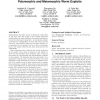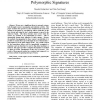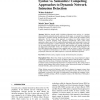142 search results - page 20 / 29 » Polymorphic On-Chip Networks |
TON
2010
13 years 6 months ago
2010
—It is crucial to detect zero-day polymorphic worms and to generate signatures at network gateways or honeynets so that we can prevent worms from propagating at their early phase...
CCS
2005
ACM
14 years 1 months ago
2005
ACM
Vulnerabilities that allow worms to hijack the control flow of each host that they spread to are typically discovered months before the worm outbreak, but are also typically disc...
ICCCN
2007
IEEE
14 years 1 months ago
2007
IEEE
—Worms are a significant threat to network systems, both through resource consumption and malicious activity. This paper examines the spread of a class of hitlist-based worms tha...
IJSN
2008
13 years 7 months ago
2008
: Malicious network traffic, including widespread worm activity, is a growing threat to Internet-connected networks and hosts. In this paper, we consider two competing approaches t...
CCS
2007
ACM
13 years 11 months ago
2007
ACM
Remotely-launched software exploits are a common way for attackers to intrude into vulnerable computer systems. As detection techniques improve, remote exploitation techniques are...



